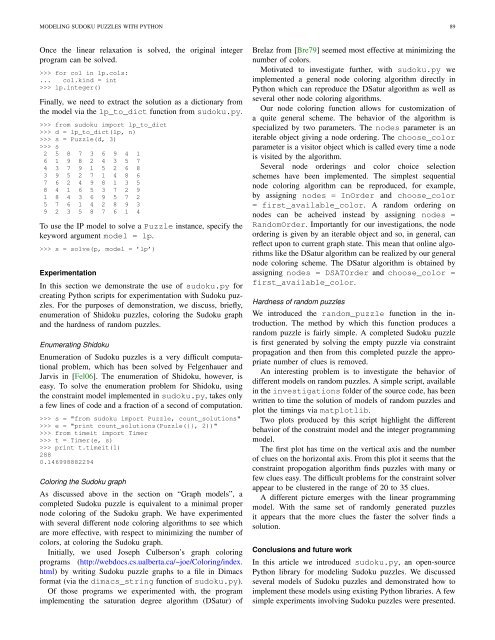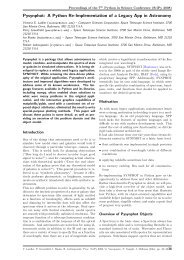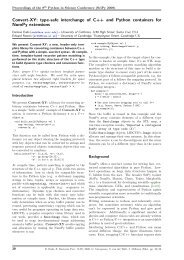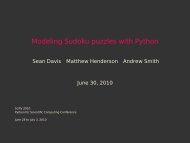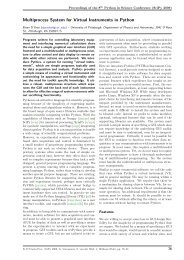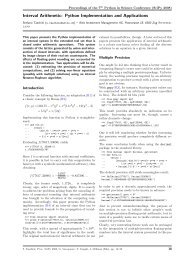Create successful ePaper yourself
Turn your PDF publications into a flip-book with our unique Google optimized e-Paper software.
MODELING SUDOKU PUZZLES WITH PYTHON 89Once the linear relaxation is solved, the original integerprogram can be solved.>>> for col in lp.cols:... col.kind = int>>> lp.integer()Finally, we need to extract the solution as a dictionary fromthe model via the lp_to_dict function from sudoku.py.>>> from sudoku import lp_to_dict>>> d = lp_to_dict(lp, n)>>> s = Puzzle(d, 3)>>> s2 5 8 7 3 6 9 4 16 1 9 8 2 4 3 5 74 3 7 9 1 5 2 6 83 9 5 2 7 1 4 8 67 6 2 4 9 8 1 3 58 4 1 6 5 3 7 2 91 8 4 3 6 9 5 7 25 7 6 1 4 2 8 9 39 2 3 5 8 7 6 1 4To use the IP model to solve a Puzzle instance, specify thekeyword argument model = lp.>>> s = solve(p, model = ’lp’)ExperimentationIn this section we demonstrate the use of sudoku.py forcreating <strong>Python</strong> scripts for experimentation <strong>with</strong> <strong>Sudoku</strong> puzzles.For the purposes of demonstration, we discuss, briefly,enumeration of Shidoku puzzles, coloring the <strong>Sudoku</strong> graphand the hardness of random puzzles.Enumerating ShidokuEnumeration of <strong>Sudoku</strong> puzzles is a very difficult computationalproblem, which has been solved by Felgenhauer andJarvis in [Fel06]. The enumeration of Shidoku, however, iseasy. To solve the enumeration problem for Shidoku, usingthe constraint model implemented in sudoku.py, takes onlya few lines of code and a fraction of a second of computation.>>> s = "from sudoku import Puzzle, count_solutions">>> e = "print count_solutions(Puzzle({}, 2))">>> from timeit import Timer>>> t = Timer(e, s)>>> print t.timeit(1)2880.146998882294Coloring the <strong>Sudoku</strong> graphAs discussed above in the section on “Graph models”, acompleted <strong>Sudoku</strong> puzzle is equivalent to a minimal propernode coloring of the <strong>Sudoku</strong> graph. We have experimented<strong>with</strong> several different node coloring algorithms to see whichare more effective, <strong>with</strong> respect to minimizing the number ofcolors, at coloring the <strong>Sudoku</strong> graph.Initially, we used Joseph Culberson’s graph coloringprograms (http://webdocs.cs.ualberta.ca/~joe/Coloring/index.html) by writing <strong>Sudoku</strong> puzzle graphs to a file in Dimacsformat (via the dimacs_string function of sudoku.py).Of those programs we experimented <strong>with</strong>, the programimplementing the saturation degree algorithm (DSatur) ofBrelaz from [Bre79] seemed most effective at minimizing thenumber of colors.Motivated to investigate further, <strong>with</strong> sudoku.py weimplemented a general node coloring algorithm directly in<strong>Python</strong> which can reproduce the DSatur algorithm as well asseveral other node coloring algorithms.Our node coloring function allows for customization ofa quite general scheme. The behavior of the algorithm isspecialized by two parameters. The nodes parameter is aniterable object giving a node ordering. The choose_colorparameter is a visitor object which is called every time a nodeis visited by the algorithm.Several node orderings and color choice selectionschemes have been implemented. The simplest sequentialnode coloring algorithm can be reproduced, for example,by assigning nodes = InOrder and choose_color= first_available_color. A random ordering onnodes can be acheived instead by assigning nodes =RandomOrder. Importantly for our investigations, the nodeordering is given by an iterable object and so, in general, canreflect upon to current graph state. This mean that online algorithmslike the DSatur algorithm can be realized by our generalnode coloring scheme. The DSatur algorithm is obtained byassigning nodes = DSATOrder and choose_color =first_available_color.Hardness of random puzzlesWe introduced the random_puzzle function in the introduction.The method by which this function produces arandom puzzle is fairly simple. A completed <strong>Sudoku</strong> puzzleis first generated by solving the empty puzzle via constraintpropagation and then from this completed puzzle the appropriatenumber of clues is removed.An interesting problem is to investigate the behavior ofdifferent models on random puzzles. A simple script, availablein the investigations folder of the source code, has beenwritten to time the solution of models of random puzzles andplot the timings via matplotlib.Two plots produced by this script highlight the differentbehavior of the constraint model and the integer programmingmodel.The first plot has time on the vertical axis and the numberof clues on the horizontal axis. From this plot it seems that theconstraint propogation algorithm finds puzzles <strong>with</strong> many orfew clues easy. The difficult problems for the constraint solverappear to be clustered in the range of 20 to 35 clues.A different picture emerges <strong>with</strong> the linear programmingmodel. With the same set of randomly generated puzzlesit appears that the more clues the faster the solver finds asolution.Conclusions and future workIn this article we introduced sudoku.py, an open-source<strong>Python</strong> library for modeling <strong>Sudoku</strong> puzzles. We discussedseveral models of <strong>Sudoku</strong> puzzles and demonstrated how toimplement these models using existing <strong>Python</strong> libraries. A fewsimple experiments involving <strong>Sudoku</strong> puzzles were presented.


